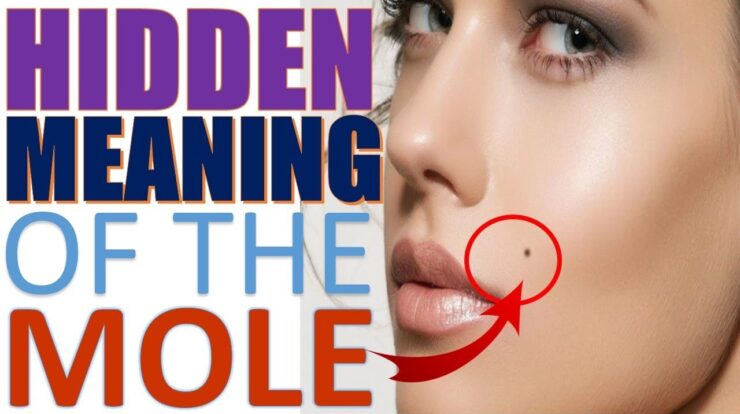
Mole meaning – Moles, those small, dark spots that adorn our skin, hold a fascinating tapestry of meanings that span biology, culture, and even the realm of cosmetics. From their biological origins to their cultural significance, from their medical implications to their cosmetic considerations, moles invite us on an enthralling journey of discovery.
Emerging from diverse linguistic roots, the term “mole” has evolved over time, reflecting the multifaceted nature of these skin formations. Biologically, moles are defined as small, pigmented areas on the skin, ranging from congenital to acquired. Their formation is influenced by a complex interplay of factors, including sun exposure and genetics.
Etymology of “Mole”

The term “mole” has a rich etymological history, tracing its roots back to different languages and cultures. In Old English, the word “mol” referred to a dark spot on the skin, possibly derived from the Proto-Germanic term “mala,” meaning “blemish” or “spot.”
In Latin, the word “macula” was used to describe a stain or mark, and this term later evolved into the French “mole,” which entered the English language in the 14th century.
Over time, the meaning of “mole” has expanded beyond its original definition to include various types of skin growths and blemishes. In the 16th century, the term was used to describe a type of birthmark, and in the 19th century, it was applied to cancerous skin lesions.
Biological Meaning
In biology, a mole is a small, dark spot on the skin that is caused by a cluster of pigment-producing cells called melanocytes. Moles can vary in size, shape, and color, and they can appear anywhere on the body.
There are several types of moles, including congenital moles, which are present at birth, and acquired moles, which develop later in life. Dysplastic moles are a type of acquired mole that is characterized by an irregular shape and border, and they are considered to be a risk factor for melanoma, a type of skin cancer.
The formation of moles is influenced by a combination of factors, including sun exposure and genetics. Exposure to ultraviolet radiation from the sun can stimulate the production of melanin, the pigment that gives moles their color. Genetics also plays a role in mole formation, as some people are more likely to develop moles than others.
Cultural and Literary Significance
Moles have held cultural and literary significance for centuries. In some cultures, moles are considered to be a sign of beauty, while in others they are associated with mystery or fate. In ancient Greece, moles were thought to be a mark of the goddess Aphrodite, and in ancient Rome, they were believed to be a sign of good luck.
Moles have also been a popular subject in literature and art. William Shakespeare famously wrote about a character with a “fair mole” on her neck, and the author Vladimir Nabokov wrote a novel about a man who is obsessed with a woman’s mole.
In art, moles have been used to convey a variety of emotions and meanings, from beauty and sensuality to mystery and intrigue.
Medical Implications
Moles are generally harmless, but some moles can develop into skin cancer, such as melanoma. Melanoma is the most serious type of skin cancer, and it is important to be able to recognize the signs and symptoms of this disease.
The most common signs of melanoma include:
- A change in the size, shape, or color of a mole
- A mole that bleeds, crusts, or oozes
- A mole that has an irregular border or is asymmetrical
- A mole that is larger than 6 millimeters in diameter
If you notice any of these changes in a mole, it is important to see a doctor for a diagnosis. Early detection and treatment of melanoma is essential for a successful outcome.
Mole Removal Techniques: Mole Meaning
| Technique | Advantages | Disadvantages |
|---|---|---|
| Laser therapy | – Precise removal
|
– Can be expensive
|
| Excision | – Permanent removal
|
– May leave a scar
|
| Cryosurgery | – Quick and easy
|
– Not suitable for all types of moles
|
Cosmetic Considerations
Moles can have a significant impact on self-image and appearance. Some people may choose to remove moles for cosmetic reasons, while others may choose to conceal them with makeup or camouflage creams.
There are a variety of methods for removing moles for cosmetic reasons, including laser therapy, excision, and cryosurgery. The best method for removing a mole will depend on the size, location, and type of mole.
If you are considering removing a mole for cosmetic reasons, it is important to consult with a qualified dermatologist or plastic surgeon to discuss the best options for you.
End of Discussion

As we delve deeper into the world of moles, we uncover their profound cultural and literary significance. Moles have been imbued with symbolism and meaning across societies, often associated with beauty, mystery, and even fate. Literature and art have immortalized moles, bestowing upon them an aura of intrigue and allure.
However, moles also hold medical implications, as they have the potential to develop into skin cancer. Understanding the different types of moles and their risk factors is crucial for early detection and treatment. Various mole removal techniques are available, each with its own advantages and disadvantages, empowering individuals to make informed decisions about their mole management.
General Inquiries
What is the difference between a congenital and an acquired mole?
Congenital moles are present at birth, while acquired moles develop later in life due to sun exposure or other factors.
Can moles be cancerous?
Yes, some moles can develop into skin cancer, particularly if they change in size, shape, or color.
How can I remove a mole?
There are several mole removal techniques available, including laser therapy, excision, and cryosurgery. The best method depends on the type of mole and individual circumstances.
Can moles be concealed for cosmetic reasons?
Yes, moles can be concealed using makeup, camouflage creams, or laser treatments, depending on their size, location, and type.





